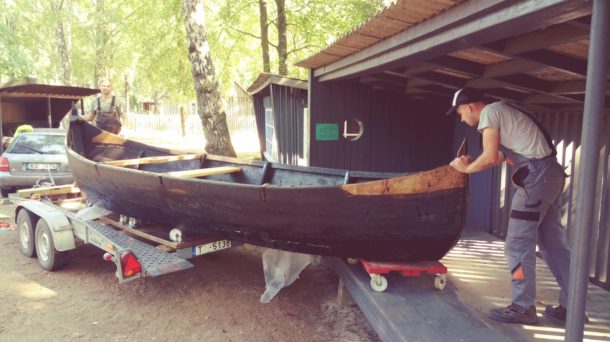
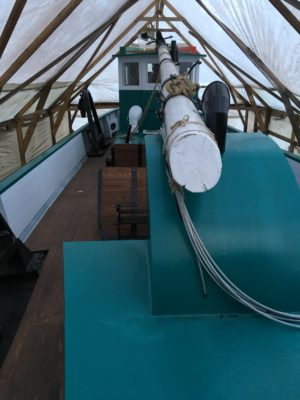
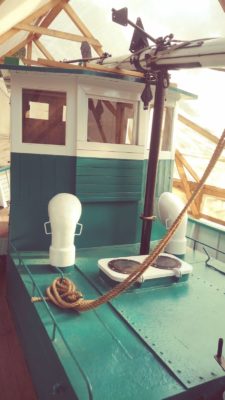
In August 2018 has been completed the project “Restoration of historic fishing boats, cutter and ancient sailing objects and the creation of an exposition” as part of the European Maritime and Fisheries Fund Operational Program for Fisheries Development 2014-2020 “Implementation of Publicly Driven Local Development Strategies” at the Ventspils Seaside Open Air Museum. Former successful director of Ventspils Seaside Open-Air Museum Andis Dūdiņš took care of this project.
Within the framework of the project, the fishing boat MB-20 “Vienība”, the flatbed fishing boat and 3 fishing boats were restored.
Within the framework of the project, also details of the sailing vessel were restored: centreboard, two fragments of a sailboat wreck, a middle part of 19th-century sailboat mast, a sailboat deck beam – support, a sailboat rudder.
Under the guidance of the master, the head of the association “Rīgas Kuģis/Riga Ship” Aigars Baiks and the master Aigars Ābelītis, the fishing boat MB-20 “Vienība”, the flatbed fishing boat and all the sailboat details were restored. 3 fishing boats were renovated by master Oto Dzenis. It should be noted that the renovation works within the project were supervised by the member of the association “Rīgas Kuģis/Riga Ship” Viktors Saulītis who is builder of many boats and yachts.
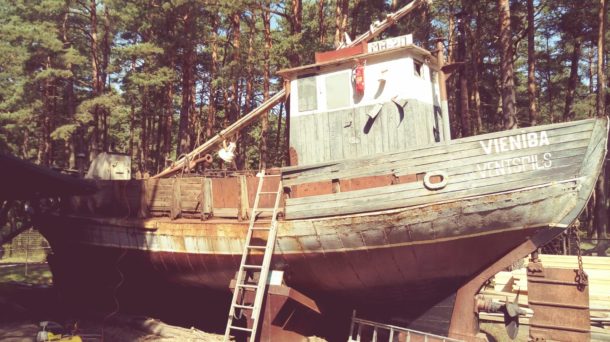 Fishing boat MB-20 “Vienība” before restoration. Photo A.Baiks
Fishing boat MB-20 “Vienība” before restoration. Photo A.Baiks
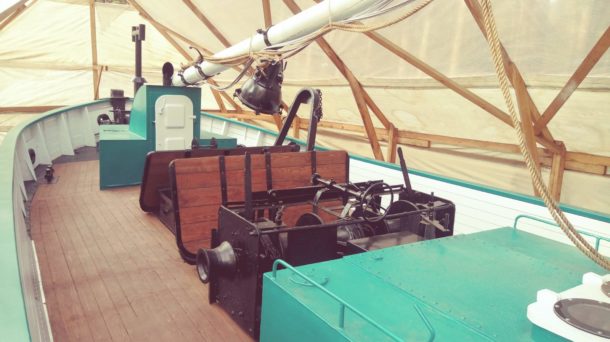
Deck and mast of restored fishing boat MB-20 “Vienība”. August 2018. Photo A.Baiks
Fishing boat MB-20 “Vienība” (inventory no. VZBM 4588, length – 14.00 m, width – 4.50 m, height of board – 6.00 m) is made of wood, part of the shell in the ice band is covered with metal. Engine power – 58.9 kW/80 hp. Built in 1954 at Mangali Shipyard. The Ventspils Fishermen’s kolkhoz “Red Lighthouse” bought this cutter in 1955 and at that time it was one of the first fishing boats in the kolkhoz. In 1967 the cutter was sold to Roja fishermen kolkhoz “Banga”. The first captain of the ship was Artūrs Krēbss, also called the “Flounder King”, the last captain – Rūdolfs Freibergs. The museum handed it over in 1977.
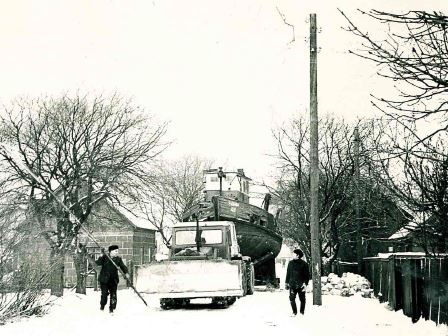
Shifting of fishing boat MB-20 “Vienība”. From Ventspils Fishing harbour to the Ventspils Seaside Open Air Museum on January 6, 1978. Enkuru Street. In front on the right side – Imants Dimza, on the left side Rūdolfs Elbergs. Photo T.Glaubics
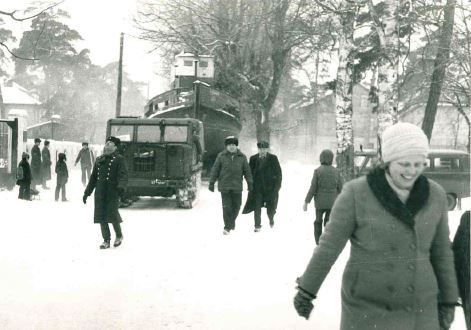
Shifting of fishing boat MB-20 “Vienība”. From Ventspils Fishing harbour to the Ventspils Seaside Open Air Museum on February 7, 1978. Parka Street. In front – director of museum Īrisa Māliņa. Photo T.Glaubics
The shifting of the fishing boat MB-20 “Vienība” from Ventspils Fishing harbour to the Ventspils Seaside Open-Air Museum took place in 1978 in several stages. On January 6, 1978, it was relocated from Ventspils Fishing harbour with the help of a wheeled tractor (from Michurina kolkhoz) and a crawler tractor (from Tin cans workshop). It was managed to move fishing boat till Enkuru Street. During the shifting, the following problems were encountered: the issue of narrow junctions had to be solved, as well as the contact of the low-power lines with the superstructure of the fishing boat.
On the February 7, 1978 the carriage of the fishing boat continued through the narrow streets of Ventspils Ostgals – Enkuru, Medņu, Loču, Parka, Vasarnīcas, Riņķa Street.
During restoration following was done – replacement of wooden mast, restoration of winches, their mounting, mast reinforcement. Following parts were completely replaced – superstructure roof, deck and boards, metal in the ice band.
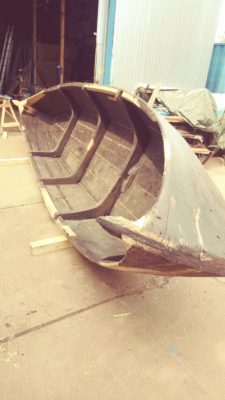 Flatbed fishing boat before restoration. Photo A.Baiks
Flatbed fishing boat before restoration. Photo A.Baiks
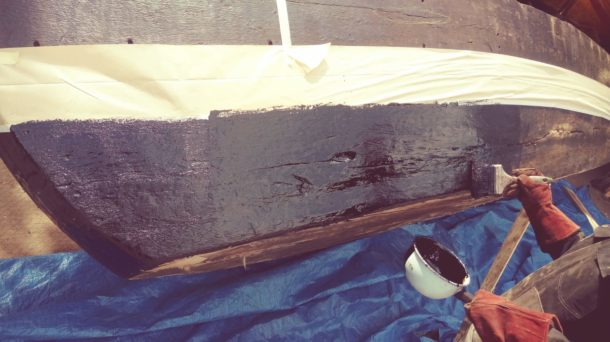
Flatbed fishing boat – applying of hot pitch. Photo A.Baiks
Flatbed fishing boat (inventory no. VZBM 2473, length – 6.10 m, width – 1.00 m, height of board – 0.60 m) is made of oak, tarred, built in smooth joint. Its capacity is 1-1.5 tons. Powered by paddles, sails can be added if necessary. The assumption is that it was built in the 19th century. Found in the Venta River at Pasiekste, about 10 km from Ventspils. It was moved to the museum in 1960.
The fishing boat was cleaned from the old tar and pitch layer and restored in the following order: tar application – filling plank gaps with oakum – applying hot pitch. The first coat of tar was applied with liquefied turpentine, the latter undiluted. The pitch was obtained from a fisherman in Engure and was fired on a campfire for immediate application in 2 layers.
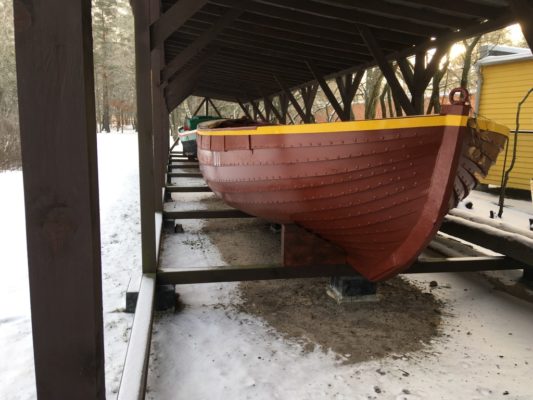 Exterior of fishing motorboat “Ventspils 011”. Photo I.Stelpa
Exterior of fishing motorboat “Ventspils 011”. Photo I.Stelpa
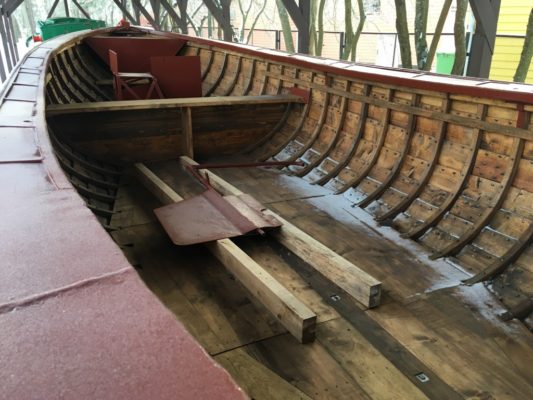
Deck of fishing motorboat “Ventspils 011”. Photo I.Stelpa
Fishing motorboat “Ventspils 011” (inventory no. VZBM 8831, length – 9.20 m, width – 2.70 m, height of board – 1.02 m, draught – 0.74 m) is made of wood. Built in Ventspils in 1990. Boat capacity is 3 tonnes. It was used in fishing in Ventspils until 2002. This boat was handed over to the museum on September 3, 2002 by Jānis Otomers.
During restoration following was done – renovation of metal constructions, paint finishing, forepeak fabrication.
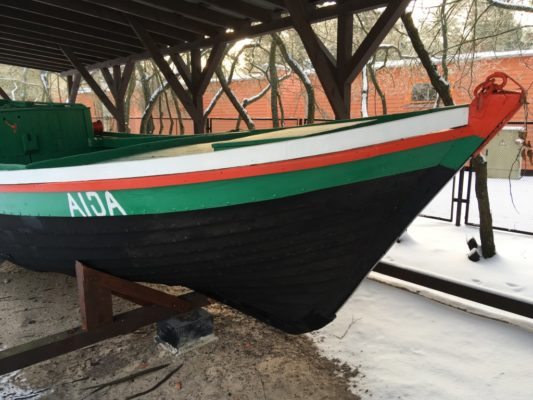 Exterior of fishing motorboat “Aija” VP017”. Photo I.Stelpa
Exterior of fishing motorboat “Aija” VP017”. Photo I.Stelpa
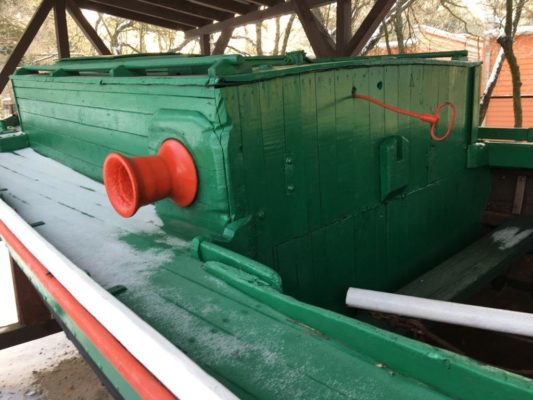 Superstructure of fishing motorboat “Aija” VP017”. Photo I.Stelpa
Superstructure of fishing motorboat “Aija” VP017”. Photo I.Stelpa
The fishing boat “Aija” VP017 (inventory no. VZBM 9660, length – 9.50 m, width – 2.80 m, height of the board – 1.40 m) is made of wood. It also had an engine – 14.7 kW/19.9 hp. It’s gross capacity – 6.3 tonnes, carrying capacity – 3 tonnes. Built in Roja in 1994. It was used in fishing on the Staldzene coast until 2009. This boat was handed over to the museum on September 15, 2009 by Benita Gardere – owner of fishing enterprise “Beta-2”.
During restoration following was done – repairs on the right board, boom-beam, kingboard, decking, stringer making on both boards.
Fishing motorboat (inventory no. VZBM 6973, length – 12.50 m, width – 2.95 m, height of board – 1.30 m, draught- 0.80m) is made of pine, ribs from oak. It also had an engine – 36.8 kW/50 hp. It’s gross capacity –- 5 tonnes. Boat master Didriķis Valds built it in Ventspils in 1980 for Ventspils Fishermen’s kolkhoz “Red Lighthouse” Staldzene Brigade. This boat was used for flounder fishing on the seashore. Last captain was E.Dubenlāže.
During restoration following was done – repairs of bay, the removal of the old paint from hull construction.
After the restoration, this boat has not yet returned to the museum because it is waiting for the museum’s next project, in which it is planned to build a 2-floor building.
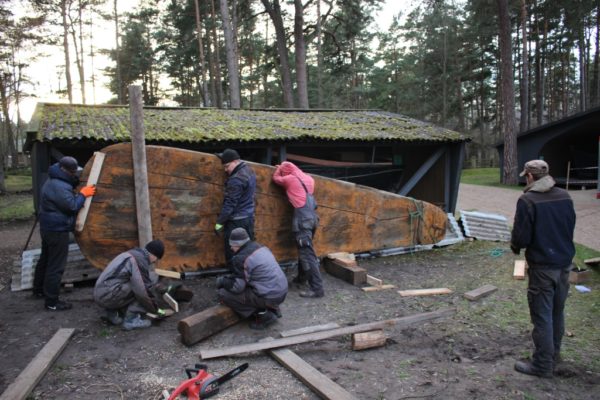
Centreboard before restoration. Photo A.Vējkrīgeris
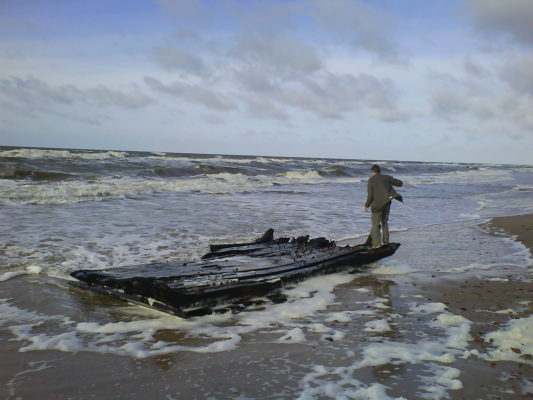
Sailboat wreck by Užava, 2009.gadā. Photo A.Vējkrīgeris
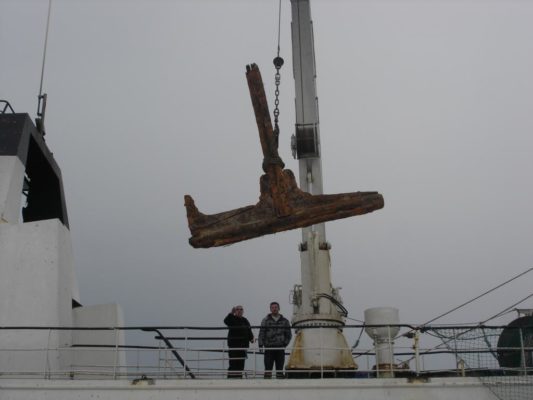
Sailboat deck beam – support before restoration. Photo A.Vējkrīgeris
Centreboard (inventory no. VZBM Plm 2473), two fragments of sailboat wreck (inventory no. VZBM Plm 2096/1-2), sailboat deck beam – support (inventory no. VZBM Plm 2474), sailboat rudder (inventory no. VZBM 187) were cleaned, damages removed and these parts were impregnated with water based antiseptic.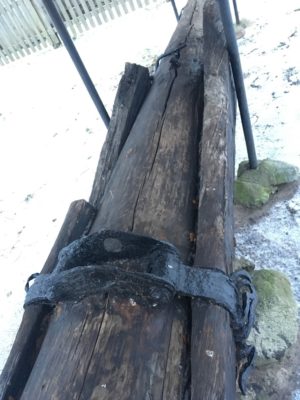
Middle part of the 19th century sailboat mast after restoration. Photo I.Stelpa
The middle part of the 19th century sailboat mast (inventory no. VZBM 3430) was cleaned, damages were removed and the mast was tarred.
The next project of Ventspils Seaside Open-Air Museum is to build a 2-floor building for boats in the museum. The mast of a fishing boat MB-20 “Vienība”, which will be located in an illuminated glass tower, will be the dominant of the building.
/The material was prepared by Ilze Stelpa in cooperation with the former director of the Ventspils Seaside Open-Air Museum Andis Dūdiņš, the Board chairman of the association “Rīgas Kuģis/Riga Ship” and the boat restaurateur in project Aigars Baiks, member of the association “Rīgas Kuģis/ Riga Ship” and restoration work supervisor in project Viktors Saulītis.
Ventspils Seaside Open-Air Museum archive materials, photos from Aigars Baiks, Ilze Stelpa and Aigars Vējkrīgeris collections are used in the article and in historical photographs./

